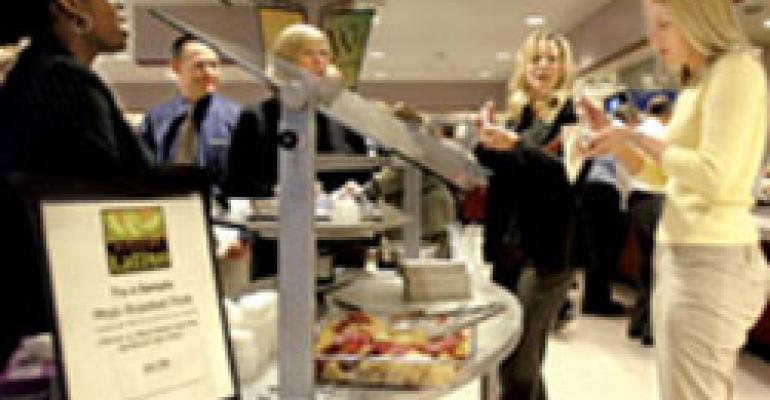The slowing economy, a new generation of workers with different dining expectations and changing corporate policies are hurting sales in the business-and-industry sector and forcing contractors to rethink their operations.
Even as more workers bring lunches from home in response to the economic slowdown, B&I operators also are grappling with demographic shifts that will continue to affect their businesses after the economy improves. Among these shifts are the growing number of telecommuters and employees who work flexible, nontraditional hours, and the swelling ranks of convenience-oriented millennials, whose idea of lunch differs vastly from the baby boomers who preceded them.
According to a study conducted earlier this year, lunch participation at corporate-dining accounts has dipped 10.1 percent during the last five years. The study, conducted by Corporate Dining Inc., a foodservice-consulting firm based in Chagrin Falls, Ohio, found that in 2007 approximately 39 percent of employees participated in on-premises lunch programs, down from 43.4 percent in 2004. The data, which was collected for a private study to be used by 80 U.S. corporations, was compiled from 1,000 records from 600 cafeterias across the country.
In another study conducted for the Society of Foodservice Management, Corporate Dining found on-site lunch participation decreased from 42.7 percent in 2004 to 39.4 percent in 2006, a decline of nearly 8 percent in approximately two years. The SFM data, which is part of a benchmarking study conducted every two to three years for the organization, will be released sometime next month.
“To me, this really verifies the trend,” said Tom Newcomb, Corporate Dining’s founder. “When two separate data pools report virtually the same data, that really locks it in.”
Newcomb said one reason for the decline is the workforce’s changing demographic from baby boomers to millennials.
“With the baby boomers retiring, the millennial generation is now a new customer and very different,” he said. “The baby boomers were very ‘lights, camera, action,’ into display cooking and entertainment. But millennials are very grab-and-go, convenience-oriented. It’s going to be very challenging for [on-site feeders] to get this.”
Newcomb noted the downturn in sales could affect the way meals are sold in the future and the designs of future cafeterias.
“Every foodservice operation is in constant change, and they will need to make adaptations,” he said. “I’m not saying they’ll be downgrading [services], but they’ll have to make adjustments.”
Industry consultant Tom Mac Dermott, founder of the Kingston, N.H.-based Clarion Group, said an increase in telecommuting also is hindering B&I sales.
“We’re working with one company in a suburban facility that has about 500 employees, and they are encouraging their employees to work from home at least one day a week,” he said. “On Friday, for example, their population and [the dining room’s] customer count is half of what it normally would be.”
Mac Dermott added that flex-time schedules also are affecting lunchtime sales.
“A lot of companies are allowing their employees to come in early and leave early,” he said. As a result, we’re seeing the breakfast daypart staying equal or rising while lunch falls. People who come in at 6 in the morning take a break and then leave before lunch.”
He also said because of the current economic uncertainty, more employees are bringing their lunches because no one “wants to run down to the cafeteria and spend an extra five bucks.”
Those customers who do buy items at B&I accounts are moving away from hot foods, Mac Dermott said. The salad bar now is generating the majority of sales at corporate cafeterias, he said.
Pointing to the accounts for which he has consulted, Mac Dermott said: “About 20 percent of all sales generated came from the salad bar, while grill items, including burgers, were way down. Hot food generated about 15 percent of all sales but 35 percent of labor costs. So in effect, the highest-priced people produced the tiniest percentage of sales, and this is fairly typical.
“Operators have to see what’s happening and adapt to it. Instead of just opening the doors in the morning and serving whoever comes in, they have to take the initiative and find out how to improve sales. The first question to ask is why, and the next is what do we do about it? Too often that question is not asked.”
Increased food costs are wreaking havoc on corporate dining as well. With prices reportedly rising more than 4 percent last year and, according to the U.S. Department of Agriculture, another 4 percent this year, operators are being forced to raise check averages or cut staff to accommodate costs.
“With the price increases of corn, flour and dairy, self-ops and contract operators are having to adjust pricing more often than they’d like to,” said John Cornyn, founder and chief executive of Portland, Ore.-based consulting firm the Cornyn-Fasano Group. “In corporate dining, it’s very difficult to generate revenues in such a short period of time. Because lunch offers a very limited window in which to meet financial expectations, it’s never advisable to diminish quality, but it is advisable to offer far lower cost options or bundle different items. The answer is to come up with imaginative ways to increase revenues and in some cases cut staff or hours of operation. More limited service, like kiosks or vending operations, are much easier to maintain than staffed positions.”
Despite the difficult environment, Newcomb said sales should increase once “on-site providers and [clients] figure out a solution.”
“It’s going to level off once they understand who the new customers are,” he said.
But Cornyn advised that tough times are still ahead.
“Batten down the hatches for the next year,” he said. “Everyone I’m talking to doesn’t see the light at the end of the tunnel. It’s going to take a while for us to ride this storm out.”





